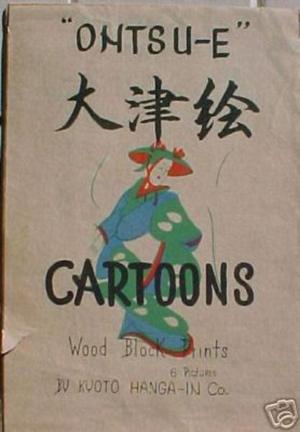Japanese Print "Album" by Iwasa Matabei
Artist:Iwasa Matabei
Title:Album
Date:Not set
Details:More information...
Source:Japanese Art Open Database
Browse all 17,130 prints...
Description:
2006年2月15日 I purchased this set of prints at an estate sale belonging to a U.S. Armed Forces man stationed in Korea in the 1950s. I assume he traveled to Japan during that time and purchased these. I will do my best to describe them. Please email me with any questions. This is a six print portfolio published by KYOTO HANGA-IN CO. Printed on Foil, each measures approx. 7 x 9 inches and are mounted on card stock paper measuring 9 x 12 inches. Portfolio 9 1/2 x 13 1/2 inches in a tri-fold with end flaps of manila card stock. The enclosure reads: The Second Series of OH-TSU-E BY MATABEI (Satirical pictures by "Matabei") In view of your appreciation for the first series of Matabei's satirical pictures, we have published the second series which we hope meets with your approval. OH-TSU is the name of the province near KYOTO where Matabei, this cynical artist lived 300 years ago. "E" means picture(s). The literary translation, then of OH-TSE-E means "picture from Oh-tsu province." At the present time, OH-TSU-E has come to be interpreted as satirical pictures by Matabei. He was a rather eccentric man who by no means would bend to flatter the public. For this reason, although his works were popular, he remained obscure and poor until long after his death. 1. "Ohmu" or parrot: A parrot is depicted in this picture as a pompous and funny bird. This bird was introduced for the first time to Japan by the Spaniards and Dutch 300 years ago during the life of this painter and Japanese war-lords and rich people then bought these birds which were very expensive. They fed and displayed them just to show off. This cynical artist criticized in satire the Japanese tendency to follow blindly or to imitate others by making this bird, which mimicked others voices, appear ridiculous. 2. "Fuji-Musume" or Wisteria Girl: This is one of the most popular classic dances which has been danced since a long time ago. This dance requires quite a long and arduous practice to perform correctly. You will be charmed by this dance in which womanly gentleness is symbolized in wisteria. You will understand very easily that the shape of wisteria reminds one of a beautiful lady. 3. "Ushiwakamaru" (Tradidtion of famous war-lord 1100-1200): It is almost traditional now although it is based upon history. Ushiwakamaru was the boyhood name of Minamotono Yoshitsume. He was a famous war-lord and strategist who conquered the "Heike Clan" He encountered a stout priest guard when he was a boy and made him surrender to him. This priest named Benkei, was believed to have unparralleled power. Benkei, a giant, was beaten by this boy's skilful tactics as he jumped and dodged here and there, while Benkei wielded a big halbert. No sooner had his halbert reached this boy than he jumped up on the railing of a bridge. Benkei then could not even touch him. 4. "Oni no Nenbutsu" or "Prayer of Devil" A devil is believed to be originally merciless. His pleasure seems to be in torturing others. It is unimaginable, therefore, that a devil would pray to Buddha for entrance into Nirvana to die peacefully. Here is a satirical picture criticizing a covetous and pitiless man going to a temple or contributing his money to charity work. This is the counterpart of "crocodile tears" 5. "Benkei no Tsurigane" or Benkei's Temple-Bell: Benkei was a very strong man with enormous muscles who lived during the so-called Gen-pei Era (1100-1200). Many stories about Benkei have been told because he was almost a giant. One day he carried the templebell of the Mii Temple near Oh-tsu from the summit of a mountain down to a town. He later returned this huge and heavy bell to the bell-tower on the same mountain. Rice cakes are sold at the tea house of this temple now and are called "Benkei-Mochi". Those who eat this rice cake at this temple are said to become strong man because Benkei himself ate rice cake here. 6. "Hato" or Doves: In these two doves we don't see any particular satire but any bird or flower which is painted give us some strange feelings. Anyway doves have been regarded as sacred birds in Japan. Hence it is very possible that Matabei must have felt some familiarity with such subjects even though he painted them in such a strange way. Edited and Translated by Mr. Fumio Shiraishi, Cultural Advisor, Kyoto Hanga-In Co. LTD. WOOD BLOCK PRINTED BY KYOTO-HANGA-IN CO, LTD YANAGINOBAMBA SHIJO MINAMI KYOTO JAPAN. All of the above descriptions are printed on a paper included in the portfolio. As you can see in the picture, the portfolio does have a tear on the front. Prints are in unmarred condition.
